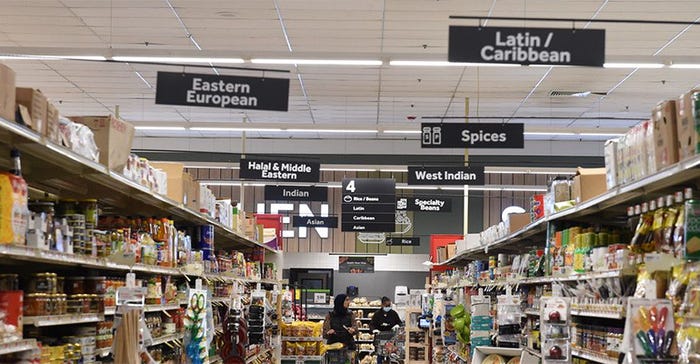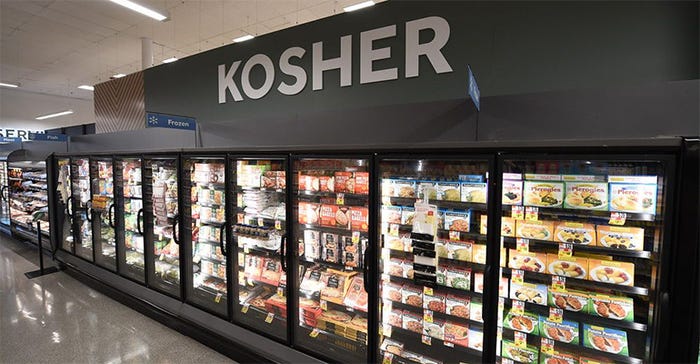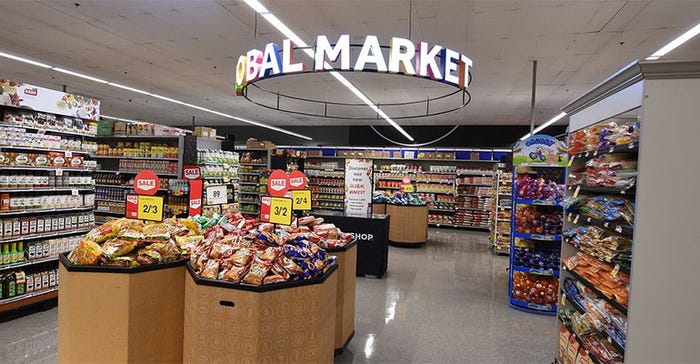Stop & Shop refocuses its multicultural aisles for local shoppers
Four of the chain's retail stores offer numerous aisles that reflect their communities' racial, ethnic, religious and cultural backgrounds.
July 18, 2023

While the so-called ethnic aisle has served as the catch-all for ingredients from different cuisines and cultures, some grocers are curating their selections so it doesn't feel like a hodgepodge of products that they haven't figured out how to fit elsewhere.
Four New York City Stop & Shop stores expanded what the grocer calls its "multicultural aisles" by tapping into the diverse demographics of the neighborhoods where the stores are located.
One Brooklyn Stop & Shop is now stocked with an assortment of specialty and local products catering to Eastern European customers as well as people looking for kosher goods.
At a Stop & Shop location in the Bronx, shoppers will find a vastly different array of goods. Like the other store, it also carries specialty and local products, but its selection is meant to serve shoppers with West African, Jamaican, Indian, Chinese, Puerto Rican and Dominican roots.
Deane Sullivan, Stop & Shop's manager and business strategist for multicultural and local initiatives, spearheaded this pilot project along with his team. They chose New York City because of its diversity and because it's a central hub of the regional grocer's market. Based on the positive responses so far, the grocer hopes to implement the remodeled multicultural aisles initiative in at least 14 more stores throughout the city.
Even the layout of the multicultural selection varies, with the Avenue Y store having two full aisles while the Bronx location has four full aisles. In addition to the Brooklyn and Bronx locations, stores in Glendale and Maspeth, Queens, underwent similar remodels, each tapping into its local community's racial, ethnic, religious and cultural backgrounds through food.
When implementing these in-store changes, Sullivan wanted to include multicultural assortments across different departments as well as introduce new vendors and distributors local to each store's area, he said. Stop & Shop increased its multicultural selection by 60% to 200% in these stores, he noted.
The grocer formally announced its $140 million capital investment in its New York City stores in early June 2022, and held the grand reopening of the Bay Plaza, Bronx, store on the same day.
"Some call it 'international,' some called it 'ethnic' but I think that when we say 'multicultural,' it's really to encapsulate different religions, different dietary restrictions with regards to your culture and your belief system, countries of origin and all those different kinds of nuances," Sullivan said. "So, it's really a destination...within a store."
Stop & Shop's revamp of its multicultural aisles comes at a time when grocers are facing new competition from ethnic-focused grocers, like H Mart and e-grocer Weee. It also comes as retailers are focusing more on offering a personalized selection of goods for shoppers, both in stores and online.
More and more consumers are seeking authentic cuisines and unique flavors, said Phil Lempert, founder and editor of SupermarketGuru. Traditional grocers that don't embrace global cuisine in a credible way will lose dollars to retailers who make authentic products accessible, he said.
"You've got to at some point, make a stand and say, 'OK, we're in the ethnic food business and we're going to do whatever we can to satisfy consumer needs or they're going to go to Amazon or elsewhere to get those foods,'" Lempert said.

Making customer input a top priority
Grocers need to curate their assortment based on their population base in order to try to get an advantage with global cuisine, Lempert said, stressing that getting consumer input is "critical."
When customizing each store's multicultural offerings, Sullivan not only took into account the sales data and performance of products, but also the surrounding neighborhood's demographic information to best meet the cultural needs of the community.
"We've certainly leveraged and used our consumer insights departments to really target certain locations to ask customers specifically, 'What are the brands you're looking for?' 'What can we provide across the total store?'" Sullivan said. "We then marry that in with sales insights and trends."
To discover what products shoppers want to see in a standard grocery store like Stop & Shop, Sullivan's team studied community stores with similar demographics to gain feedback from its customers in addition to conducting in-store Stop & Shop customer survey groups.
Many consumers surveyed were not comfortable using English as a first language and some preferred not to participate in surveys over the phone, he said. To accommodate these shoppers, he set up bilingual survey opportunities, gaining "honest feedback as [customers] were shopping in the store at the time of the interview."
Since the company expanded these aisles and opened them to the New York community, customer feedback shows that a majority of consumers appreciate the improved multicultural aisles, Sullivan said. The store is re-gaining shoppers it had lost as well as attracting new customers, as well.

Building vendor relationships
In revamping its multicultural aisles, Stop & Shop saw an opportunity to expand the number of vendors it works with and bring new products to its shelves. The grocer introduced between 5,000 and 8,000 new products and onboarded about 15 to 20 new vendors, distributors and other businesses for the four New York City stores, Sullivan said. Local New York City businesses account for a majority of the new additions.
Selecting vendor partners was not a process Sullivan took lightly.
"It's so easy as a white male sitting in an office in Boston to presume what culture is like or want strictly [by] looking at numbers and figures on a page," Sullivan said. "And you really need to immerse yourself in the culture."
He traveled from Boston to New York frequently to visit local restaurants, shops and even the basement of a vendor's local cheese factory to get a full understanding of every product and its maker.
By sourcing from the community, Stop & Shop can build a reputation as a discoverer of new and smaller brands, said Diana Sheehan, principal and CEO of PDG Insights.
"Retailers for decades have been using exclusive brands as a way to distinguish themselves. And so, if the retailer discovers a brand that's just starting to take off...it actually is a way to potentially drive traffic to their stores, while also building positive kind of connectivity to the communities that they're involved in," she said.
Along with authenticity, customers also want to see diverse representation and local in the multicultural assortment, Sullivan said.
A product assortment tailored to customers' needs can boost and keep loyalty, Lempert said, giving the examples of H-E-B stores making fresh tortillas daily and selling barbecued pig's head for celebratory occasions in order to cater to Hispanic shoppers.
Sheehan said Stop & Shop appears to be bridging the gap between recognizing that product assortment is the biggest way they can differentiate themselves outside of price.
"By having an assortment that is incredibly diverse and customized to their community and by including within that assortment local brands, they are at least working to build a strategy in which they hit all of the possible places in which they really can drive consumer or customer loyalty," Sheehan said.

Tailoring merchandising
Shoppers at the revamped Stop & Shop stores can find endcaps focused on significant religious and cultural events, like Ramadan.
"It is as important to celebrate different cultures and include them in your store, as a statement to say that we are here for the community, as it is from a profitability standpoint," Sullivan said.
The grocer also has signage in multiple languages along with more large display areas that focus on culturally relevant products for particular communities, Sullivan said.
For example, the grocer has a large banner with mass displays in the front of the store that says "Value every day" in multiple languages.
At the request of shoppers, Stop & Shop has made it easier for them to identify where the products are coming from with signage calling out South American, Caribbean and West Indian items, for example, Sullivan said.
Sheehan said labeling products by country of origin can help customers.
"When you think about the fact that Stop & Shop is talking about Puerto Rican cuisine, the Dominican cuisine and making sure to account for the brands and the products that might not be consistent from country to country, I think that's a really important distinguish distinction and recognition of the diversity of that population," Sheehan said.
As the U.S. Latino population grows, Lempert said having grocery workers who are bilingual is important to reduce language barriers with customers. Depending on target customer demographics for individual stores, grocers may need to have workers who know other languages.
While Stop & Shop is sticking with the standard formula of consolidating its global cuisine in designated multicultural aisles, Lempert said grocers need to pivot from this approach to integrated merchandising instead.
"If you have integrated merchandising, what you're going to do is you're going to get more consumers excited about foods that they have never seen before because there are shoppers who don't walk down the Chinese food, the kosher food, the Indian food aisle[s]," Lempert said.
As an example, Lempert pointed to the placement of Saffron Road in frozen food cases next to the Lean Cuisine-type options, naan in the bread aisle and LahVosh in the cracker section.
The current approach to stocking grocery stores' so-called ethnic aisle is a missed opportunity, according to Sullivan, who added that Stop & Shop's new approach to the store's multicultural section should be the new standard.
"The multicultural landscape, for a multitude of different reasons, is constantly evolving, and we as retailers need to follow in accordance as well," Sullivan said.

You May Also Like


